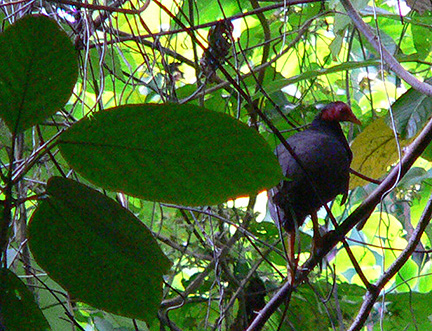Alternative name: Vanuatu Scrubfowl
- Megapodius layardi
Identification
42-45 cm.
- Dark brownish or plumbeous black plumage
- Extensive pinkish-red bare skin on face and forehead, more bare areas than any other Megapodes
- Pale yellow bill
- Bright yellow legs and feet
Sexes similar. Juveniles are duller and have browner legs and bill.
Distribution
Endemic to central and north Vanuatu.
Still common in good habitat but declining and total population around 10'000 birds. Habitat loss, egg harvesting and introduced predators are the main reasons for the decline.
Taxonomy
This is a monotypic species.
Formerly considered conspecific with Dusky Megapode. Also linked with Micronesian Megapode but probably close to Tongan Megapode.
Habitat
Moist lowland forests or thickets. Has also been recorded in gardens and degraded forest.
From sea-level up to c. 800 m.
Behaviour
Diet
Feeds on insects, grubs, snails, worms and other invertebrates. Takes also fruit, seeds and other plant matter.
Forages by scratching in damp leaf litter. Runs rather than flies away from danger.
Breeding
Breeding year-round, especially from June to August. Probably a monogamous species. Nests in burrows between decaying roots of trees, eggs are incubated in volcanically heated soils or sun-exposed beaches, possibly also in mounds. 20 to 100 eggs are laid by several females in a burrow.
Movements
A sedentary species. Sometimes flies off to roost on offshore islets.
References
- Clements, J. F., T. S. Schulenberg, M. J. Iliff, D. Roberson, T. A. Fredericks, B. L. Sullivan, and C. L. Wood. 2014. The eBird/Clements checklist of birds of the world: Version 6.9., with updates to August 2014. Downloaded from http://www.birds.cornell.edu/clementschecklist/download/
- Gill, F and D Donsker (Eds). 2015. IOC World Bird Names (version 5.2). Available at http://www.worldbirdnames.org/.
- Handbook of the Birds of the World Alive (retrieved July 2015)
Recommended Citation
- BirdForum Opus contributors. (2024) Vanuatu Megapode. In: BirdForum, the forum for wild birds and birding. Retrieved 18 April 2024 from https://www.birdforum.net/opus/Vanuatu_Megapode




